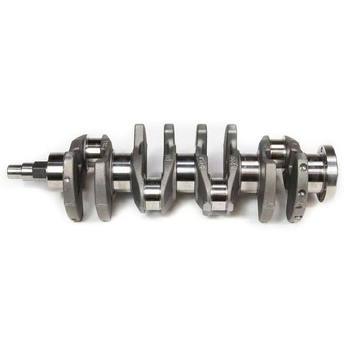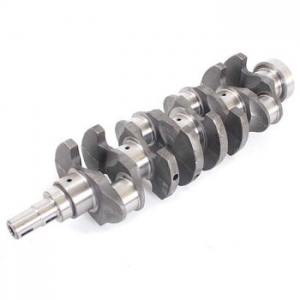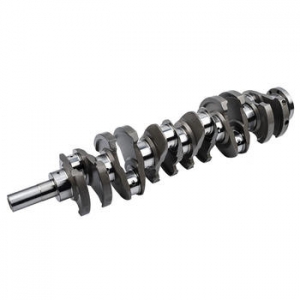Unlocking Success: Your Definitive Guide to Choosing a Wholesale Crankshaft Supplier
Views :
Update time : 2025-06-12
Frankly speaking, the heart of any internal combustion engine is its crankshaft. This critical component converts the linear motion of the pistons into rotational motion, driving everything from your daily commute to heavy industrial machinery. For businesses in the automotive repair, engine rebuilding, or manufacturing sectors, sourcing high-quality crankshafts consistently and affordably is paramount. This is where a reliable wholesale crankshaft supplier becomes an indispensable partner.
In my experience, the difference between a thriving operation and one constantly battling supply issues often boils down to the strength of its supplier relationships. Choosing the right wholesale crankshaft supplier isn't just about getting the best price; it's about ensuring consistent quality, reliable delivery, and expert support. Have you ever wondered what truly sets a top-tier supplier apart from the rest? Let's dive deep into the world of crankshaft sourcing and uncover the secrets to making an informed decision.
The Indispensable Role of a Wholesale Crankshaft Supplier in the Automotive Ecosystem
The automotive and industrial sectors operate on tight schedules and even tighter tolerances. A single faulty component can lead to significant downtime, costly repairs, and damage to a business's reputation. This is precisely why the role of a wholesale crankshaft supplier is so critical. They act as the vital link between manufacturers and the end-users, ensuring a steady, reliable flow of these essential engine components. Indented paragraph: These suppliers cater to a diverse clientele, each with unique needs: * Engine Rebuilders: Often require a wide variety of crankshafts for different makes and models, focusing on quality that meets or exceeds OEM specifications for rebuilt engines. * Automotive Repair Shops: Need quick access to specific crankshafts for urgent repairs, emphasizing availability and fast shipping. * Industrial Equipment Manufacturers: Demand robust, high-performance crankshafts for heavy-duty applications, often requiring custom specifications or large bulk orders. * Aftermarket Parts Retailers: Seek a broad inventory to serve their customer base, prioritizing competitive pricing and consistent stock. Indented paragraph: To be honest, managing inventory for such a crucial and varied part like a crankshaft is a complex undertaking. A good supplier understands market demand, anticipates trends, and maintains sufficient stock to prevent backorders that can cripple their clients' operations. They don't just sell parts; they provide solutions that keep the wheels of industry turning.
Key Factors When Evaluating a Wholesale Crankshaft Supplier
Choosing the right partner in your supply chain requires meticulous evaluation. It's not a decision to be taken lightly, as the quality of your crankshafts directly impacts the performance and longevity of the engines they power. Here are the paramount factors I've found to be crucial when selecting a wholesale crankshaft supplier: Indented paragraph:1. Product Quality and Manufacturing Standards
This is non-negotiable. A crankshaft endures immense stress, heat, and rotational forces. Its integrity is paramount. * Material Composition: Is it forged steel, cast iron, or billet? Does the supplier provide detailed material specifications? Forged crankshafts offer superior strength and durability, often preferred for high-performance or heavy-duty applications. * Manufacturing Process: What processes do they use? CNC machining, heat treatment, balancing, and surface finishing are all critical. Look for suppliers who adhere to strict quality control protocols like ISO certifications. * Tolerances and Specifications: Do their crankshafts meet or exceed Original Equipment Manufacturer (OEM) specifications? Precision in dimensions and balancing is vital for smooth engine operation and longevity. Indented paragraph:2. Inventory Depth and Availability
A supplier's ability to consistently provide the crankshafts you need, when you need them, is a cornerstone of reliability. * Breadth of Stock: Do they carry a wide range of crankshafts for various makes, models, and engine types (gasoline, diesel, marine, industrial)? A comprehensive inventory reduces your need to source from multiple vendors. * Stock Levels: Can they handle your typical order volume, whether it's a single unit or a large bulk order of "bulk engine crankshafts"? In my experience, a supplier with robust inventory management systems is a significant asset. * Lead Times: What are their typical lead times for standard and special orders? Fast and predictable delivery is crucial for managing your own project timelines. Indented paragraph:3. Pricing and Payment Terms
While quality is king, competitive pricing ensures your profitability. * Transparent Pricing: Are their prices clear, without hidden fees? Do they offer volume discounts for large orders? * Payment Flexibility: Do they offer reasonable payment terms that align with your business's cash flow? * Value Proposition: Evaluate the overall value, not just the lowest price. A slightly higher-priced crankshaft with superior quality and reliability can save you significant costs in the long run by preventing failures and warranty claims. Indented paragraph:4. Logistics and Shipping Capabilities
Efficient delivery is just as important as the product itself. * Shipping Options: Do they offer various shipping methods (ground, air freight, expedited) to meet different urgency levels? * Packaging: Are crankshafts securely packaged to prevent damage during transit? These are heavy, precision components that can be easily damaged if not handled correctly. * International Shipping: If you're an "automotive engine components distributor" with global reach, inquire about their international shipping experience, customs handling, and export documentation. Indented paragraph:5. Customer Service and Technical Support
A true partnership extends beyond the transaction. * Responsiveness: How quickly do they respond to inquiries, quotes, and support requests? * Technical Expertise: Can they provide technical guidance on crankshaft specifications, applications, or troubleshooting? Many experts agree that a supplier with knowledgeable staff is invaluable. * Returns and Warranty Policy: A clear, fair policy for returns and warranties demonstrates confidence in their products and commitment to customer satisfaction.
Understanding Different Types of Crankshafts and Their Applications
Interestingly enough, not all crankshafts are created equal. Their design, material, and manufacturing process are tailored to specific engine types and performance requirements. Understanding these distinctions is key to making informed purchasing decisions from your wholesale crankshaft supplier. Indented paragraph:Forged vs. Cast Crankshafts
* Forged Crankshafts: Made by shaping solid steel through immense pressure and heat. This process aligns the grain structure of the metal, resulting in superior strength, fatigue resistance, and durability. They are typically found in high-performance, heavy-duty, or racing engines where reliability under extreme conditions is paramount. * Cast Crankshafts: Produced by pouring molten iron into a mold. While more cost-effective to manufacture, they are generally less strong and more brittle than forged crankshafts. They are commonly used in standard production vehicles and engines that don't experience extreme loads. Indented paragraph:Applications Across Industries
The type of crankshaft you need will depend heavily on its intended application: * Automotive (Passenger Vehicles): Primarily cast iron for standard engines, with forged options for performance models. * Heavy-Duty Trucks and Buses: Almost exclusively forged steel due to the high torque, continuous operation, and heavy loads they endure. * Marine Engines: Often require specialized corrosion-resistant materials and robust designs to withstand harsh marine environments. * Industrial Engines (Generators, Pumps, Compressors): Demand highly durable and reliable crankshafts, often custom-engineered for specific industrial "industrial crankshaft sourcing" needs and continuous operation. * Motorcycles and Small Engines: Typically smaller, lighter crankshafts, often forged for higher RPM applications. Indented paragraph: It's worth noting that even within these categories, variations exist based on engine configuration (inline, V-type, flat), number of cylinders, and stroke length. A knowledgeable wholesale crankshaft supplier can guide you through these complexities, ensuring you get the exact part for your specific application.Navigating the Global Market for Crankshafts: Sourcing and Quality Control
The global marketplace offers a vast array of options for sourcing crankshafts, from domestic manufacturers to international suppliers. While global sourcing can offer competitive pricing, it also introduces complexities related to logistics, quality control, and communication. Indented paragraph:Sourcing Strategies
* Domestic Sourcing: Often provides faster lead times, easier communication, and potentially stronger legal recourse. Quality control can be more straightforward. * International Sourcing: Can offer significant cost savings, especially from regions with lower manufacturing costs. However, it requires careful vetting of suppliers, understanding import duties, and managing longer shipping times. Many companies opt for a blend of both, leveraging the strengths of each. Indented paragraph:Ensuring Quality with Overseas Suppliers
When dealing with international wholesale crankshaft suppliers, robust quality control mechanisms are absolutely vital. * Factory Audits: Conduct on-site audits or use third-party inspection services to verify manufacturing processes, quality management systems, and ethical labor practices. * Sample Testing: Before committing to large orders, request samples for rigorous testing in your own facilities or by independent laboratories. Test for material composition, hardness, dimensional accuracy, and fatigue resistance. * Clear Specifications: Provide extremely detailed technical drawings and specifications. Leave no room for ambiguity. * Third-Party Inspection: Utilize third-party inspection services at various stages of production (e.g., pre-production, during production, pre-shipment) to ensure consistent quality. * Communication: Establish clear communication channels and be mindful of time zone differences and language barriers. Indented paragraph: In my experience, building a strong, long-term relationship with an international supplier is key. It fosters trust and encourages them to maintain high standards, knowing they have a committed partner.The Future of Crankshaft Sourcing and Supply Chains
The automotive and industrial landscapes are constantly evolving, driven by technological advancements, environmental concerns, and shifting market demands. The future of crankshaft sourcing will undoubtedly be influenced by these trends. Indented paragraph:Technological Advancements
* Advanced Materials: Research into lighter, stronger, and more durable materials (e.g., advanced alloys, composites) will continue to influence crankshaft design and manufacturing. * Additive Manufacturing (3D Printing): While not yet mainstream for production crankshafts, additive manufacturing holds promise for prototyping, custom designs, and potentially even specialized, low-volume production in the future. * Digitalization of Supply Chains: Increased adoption of AI, blockchain, and IoT for inventory management, demand forecasting, and supply chain transparency will make sourcing more efficient and resilient. Indented paragraph:Sustainability and Ethical Sourcing
As environmental regulations tighten and consumer awareness grows, there will be an increased focus on sustainable manufacturing practices and ethical sourcing. This includes: * Reduced Carbon Footprint: Suppliers who adopt energy-efficient processes and minimize waste will gain a competitive edge. * Recycled Materials: The use of recycled steel in crankshaft manufacturing could become more prevalent. * Fair Labor Practices: Ensuring suppliers adhere to ethical labor standards will be increasingly important for brand reputation. Indented paragraph:Market Dynamics
The shift towards electric vehicles (EVs) will impact the long-term demand for traditional internal combustion engine (ICE) crankshafts. However, the vast existing fleet of ICE vehicles, coupled with continued demand for heavy-duty industrial and marine applications, ensures that crankshafts will remain a vital component for decades to come. The market for replacement and aftermarket crankshafts will likely remain robust. Indented paragraph: Ultimately, selecting the right wholesale crankshaft supplier is a strategic decision that impacts your operational efficiency, product quality, and bottom line. By focusing on quality, reliability, and a strong partnership, you can ensure a steady supply of these critical engine components, keeping your business running smoothly and profitably for years to come.For more detailed information, please visit our official website:wholesale crankshaft supplier
About the author: Sarah Jenkins is a seasoned expert in automotive supply chain management with over 15 years of experience. Specializing in engine components and heavy machinery parts, she has advised numerous businesses on optimizing their sourcing strategies. Her insights into quality control, logistics, and supplier relationship management have helped companies achieve significant operational efficiencies and cost savings in the competitive automotive aftermarket.
Related News
Read More >>
 Trusted Crankshaft Manufacturi
Trusted Crankshaft Manufacturi
06 .17.2025
Discover expert crankshaft manufacturing services. We offer high-quality, precision-engineered crank...
 Trusted Crankshaft Supplier |
Trusted Crankshaft Supplier |
06 .17.2025
Leading Crankshaft supplier offering high-quality, durable crankshafts for all applications. We supp...
 Trusted Crankshaft Manufacture
Trusted Crankshaft Manufacture
06 .17.2025
Leading crankshaft manufacturer offering precision-engineered components for diverse applications. T...
 Trusted Crankshaft company Man
Trusted Crankshaft company Man
06 .16.2025
Discover our premium Crankshaft company solutions. As a trusted manufacturer, we offer high-quality ...
